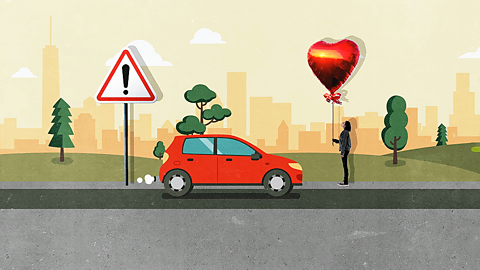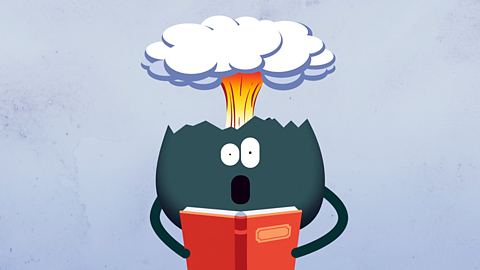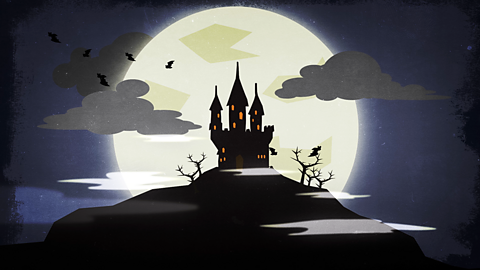Did you know?
The events in some novels and plays take place over a surprisingly short space of time.
- The events in Of Mice and Men take place over four days.
- Romeo and Juliet takes place over five days (a short amount of time to meet, fall in love and get married!).
- A Christmas Carol takes place in just one evening and night.
Introduction to setting
Key learning points
Setting is one of the most important ingredients when writing a story and writers are always deliberate in their choice of setting.
Setting is useful in establishing the time and place of the action. Setting can also:
- create atmosphere
- establish a theme or character
- establish the genre conventions of the text
- act as a symbol
Video about how writers use setting
A video about how writers use different settings and why setting is important to a story
Setting refers to the story world.
Is it daytime, or night time? Is it the past or the present? Or even the future? Where is the country? Is it peaceful or is it at war?
I think you get the picture.
When analysing setting, you can think about how it contributes to the atmosphere, themes and understanding of characters.
For example, Robert Louis Stevensonтs Strange Case of Dr Jekyll and Mr Hyde is about one man with two identities, the respectable Dr Jekyll and the evil Mr Hyde.
When he exits his house by a clean, welcoming door that leads out to bright daylight, he leaves as Dr Jekyll. You donтt need to worry about him.
By contrast, when Dr Jekyll turns into evil Mr Hyde, he uses the dirty, uninviting door from his sinister laboratory to step out into the darkness. You probably donтt want to bump into Mr Hyde late at night.
These two settings illustrate the main character swapping between good and evil, and the wider theme, that thereтs good and evil in all of us.
And the dual settings allow the author to explore contrasts between two things, such as the good and evil theme, or nature and the supernatural. Whilst being complete opposites, these character traits exist together within the world of the story.
Can you imagine this story being told in a different setting? How would it feel if Of Mice and Men was set in a Gothic castle, instead of sunny California? Or Dracula, set on a sunny Californian beach?
Dracula doesnтt cope well with the Sun. So, setting matters.
What is setting?
Setting is the backdrop of the story, where and when the action takes place. At a basic level, this the the place and time period that a piece of writing is set. For example, the story Of Mice and Men is set in California in the 1930s.
Setting can also refer to the time of day or a particular time of year. For example, A Christmas Carol is set on Christmas Eve and mainly takes place over the evening and the night.
The weather is also relevant to our understanding of setting. For example, at the start of the play Romeo and Juliet Shakespeare wants the audience to understand that the weather is hot, which perhaps helps provoke the violence on the streets.
A writer uses descriptions and other details to establish the setting clearly for the reader. The writer might choose a setting that suits the mood or genre of the story. For example, a Gothic short story could be set at night to create tension.

Which areas are most relevant to setting?
A. Character and dialogue
B. Weather and time of day
C. Metaphor and simile
B. The weather and the time of day are most relevant to setting.
Time and place
A writer will often select a place for a reason. For example, the writer John Steinbeck chose the Salinas Valley in California as the setting for Of Mice and Men because it was a place that attracted many migrant agricultural workers such as George and Lennie, the main characters of the novella.
A writer may decide to set their story in the future, in an imagined time and place. Some writers imagine a frightening time and place in the future. These types of setting are called dystopias. Examples include:
- George Orwell set his novel Nineteen Eighty-Four in an imagined future in which everyone is watched and controlled by a powerful organisation.
- The novel The Hunger Games is a story with a dystopian setting, where some of the characters are forced to fight to survive.
These types of setting create conflicts that can then lead to interesting character development or comments about society.
A writer could set their story in the past, at a particular point in history. This type of historical fiction can be an interesting way to use setting to explore important themes and questions.
Nancy Springer's novels about the fictional character Enola Holmes were written in the 21st century but are set in 19th century London. This allows the reader to see the barriers that young women faced in Victorian England.
The choice of setting
As a reader, think about why the writer has chosen this setting. Remember, the setting is not an accident, it is a deliberate choice. You could also think about how the writer uses language to create their setting.
Setting often focuses on where and when, but itтs also important to look at why and how. For example, why do you think Shakespeare chose to set his play Romeo and Juliet in Italy? How does Shakespeare show the audience that the story is set in Italy?
Writers think carefully about their choice of setting, it didnтt just happen there, the writer has specifically chosen that setting. It is a decision that is made in the early planning stages of a story.
Sometimes writers use a setting they know well and sometimes they need to do extra research on the setting to make the descriptions more convincing. This helps them to include more details to engage the reader.
Writers need to ensure they include enough detail to suggest the time of day, place, weather and time of year.
Setting, atmosphere, theme and character
Setting and atmosphere
A writerтs choice of setting is important in establishing the atmosphere of a piece of fiction. The atmosphere is the mood and tone of the story, how the story feels to the reader. For example, in the novel Wuthering Heights by Emily BrontУЋ, the setting of the isolated, wind-swept farmhouse adds to the atmosphere of tension and drama.
Setting and theme
The themes of a story are the тbig ideasт beyond the main events and plot. The setting can create and reflect the themes of a story. For example, in the novel Noughts & Crosses by Malorie Blackman, the dystopian setting creates and reflects the theme of prejudice.
Setting and characterisation
A writer may use the setting to reveal more of the character to the reader. For example, a story about a teenager struggling with friendships and their own identity could have a school setting.
Setting and genre
Setting can be an important way to establish the genre of a piece of fiction. Genre is a type of fiction, for example:
- Gothic
- romance
- science fiction
- historical fiction
- fantasy
Each type of genre has conventions. These are typical details that the reader will expect from this genre.
In terms of setting, a Gothic story will typically have a setting in an ancient castle and much of the action will take place at night in bad weather. Read more about the many conventions and traditions of Gothic literature.
In the science fiction genre, the setting may be in the future and have details about new technologies.
Sometimes a writer may play around with the conventions of a genre or even combine genres.
Setting as a symbol
A symbol can be an object, place or thing that represents something else. A setting can sometimes function as a symbol in a piece of fiction.
For example, in Noughts & Crosses the beach where the two main characters meet symbolises freedom. The physical setting of the beach has a wider significance in the story, as itтs one of the only places the characters can be themselves.
In the Gothic novella Strange Case of Dr Jekyll and Mr Hyde the setting of Victorian London, with its contrast of wealth and poverty, symbolises the different sides of human nature.

Which of these is the correct definition for symbolism?
A. An object, place or thing that represents something else.
B. Typical conventions of a type of story.
C. The mood and tone a a fictional text.
Answer: A. A symbol is an object, place or thing that represents something else.
Test your knowledge
Play Bitesize secondary games. gamePlay Bitesize secondary games
Have fun playing science, maths, history, geography and language games.

More on Critical reading
Find out more by working through a topic
- count5 of 11

- count6 of 11

- count7 of 11

- count8 of 11
